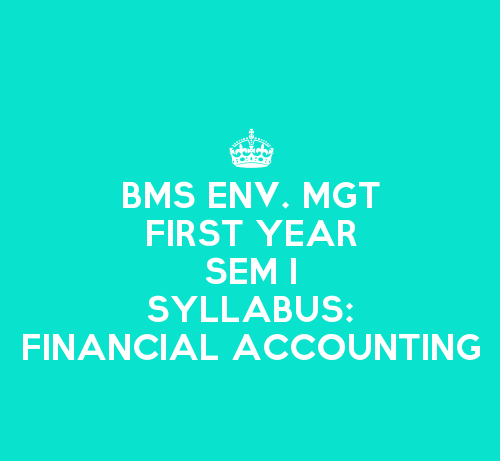Teaching hours and Assessment Pattern of Financial Accounting
- No. of sessions of 90 minutes – 30
- No. of sessions of 90 minutes per week – 2
- Continuous Assessment – 40 I A
- Semester End Examination – 60 I A
- Total marks – 100
- Duration of theory paper – 3 hours
- No. of credits – 2
The topics covered in Unit 1 are as follows:
Meaning and Scope of Accounting:
- Need,
- Development and definition,
- Book keeping and accounting,
- Persons interested in accounting,
- Disclosures,
- Branches of accounting,
- Objectives of accounting.
Accounting Transactions:
- Accounting cycle,
- Journal,
- Journal proper,
- Opening and closing entries,
- Relationship between journal and ledger,
- Rules regarding posting,
- Trial balance,
- Subsidiary books,
- Bank reconciliation statement.
Accounting Standards:
AS 1 : Disclosures of accounting policies:
- Meaning of accounting policies
- Purpose
- Different policies
- Areas of policies
- Disclosure of policies
- Disclosure of change in policies
- Simple illustrations.
AS 6: Depreciation accounting-
- Meaning,
- Definitions,
- Importance,
- Factors,
- Useful life of a depreciable asset,
- Estimating useful life,
- Additions,
- Residual value,
- Methods,
- Disclosure of surplus,
- Change in method,
- Simple illustrations.
AS 9: Revenue Recognition:
- Meaning and scope,
- Transactions excluded,
- Sale of goods,
- Rendering of services,
- Effect of uncertainties,
- Disclosure,
- Simple illustrations.
AS 10: Accounting for fixed assets:
- Meaning
- Definitions
- Importance
- Cost of fixed assets
- Self constructed fixed assets
- Non-monetary consideration
- Improvements, repairs, additions and extensions
- Revaluation
- Sale or retirement
- Valuation of fixed assets in special cases
- Special types of fixed assets
- Disclosure.
The topics covered in Unit 2 are as follows:
A.
1) Expenditure:
- Classification of expenditure, capital, revenue and deferred revenue
- Expenditure: Distinction between capital expenditure and revenue expenses
- Unusual expenses: Effect of error, critical tests.
2) Receipts:
- Capital receipt,
- Revenue receipt,
- Distinction between capital receipts and revenue receipts.
3) Profit or Loss:
- Revenue profit or loss,
- Capital profit or loss.
Depreciation Accounting:
Practical problem based on accounting treatment by provision for depreciation using SLM and RBM methods.
The topics covered in Unit 3 are as follows:
- Trial Balance and Final Accounts of a Sole Proprietor:
- Introduction to trial balance and final accounts of a sole proprietor.
- Rectification of errors.
- Preparation and Presentation of Final Accounts in Horizontal Form
- Manufacturing Account: Trading Account : Profit and Loss Account: Balance Sheet
The topics covered in Unit 4 are as follows:
- Accounting in Computerized Environment
- An overview of computerized environment
- Features of computerized accounting system
- Concept of grouping of accounts
- Codification of accounts
- Maintaining the hierarchy and ledgers
- Accounting packages and consideration of them in selection.
The list of reference books of Financial Accounting is as follows:
- An introduction to financial accounting – Andrew Thomas, McGraw Hill
- Financial Accounting : a managerial emphasis – Ashok Banerjee, Excel Books
- Financial Accounting – Weugamt, Keiso, Kimmel
- Accounting theory : an introduction – L.S.S. Porwal, Tata McGraw Hill
- Elements of accounts – T.S. Grewal, S. Chand and Co.
- Business Accounting – Frank Woods, Pitman Publication
- Advanced Accountancy – R.L. Gupta & M. Radhaswamy, S. Chand & Co. (P) Ltd., New Delhi
- Accounting Standards – Institute of Chartered Accountants of India, New Delhi
- Financial Accounting for Managerial Texts and Cases – Dr. Dinesh D. Harsolikar, Multi-Tech Publishing Co. Ltd., New Delhi
- Indian Accounting Standards and US GAAP – Ashish Bhattacharya, Tata McGraw Hill and Co. Ltd., New Delhi
- Financial Accounting – Warren, Thomson Learning
- Company Accounting Standards – Shrinivasan Anand, Taxman
- Financial Accounting – J.R. Monga, Girish Ahuja, Mayur Paper Back.




43 Comments